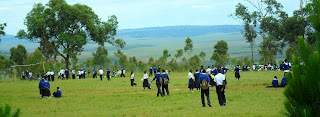National Examinations are a BIG DEAL in Tanzania. They are used to assess individual pupils and to rank schools, wards, districts and regions.
Pupils in Standard IV are tested in an exam that once determined if a pupil was promoted to Standard V. Promotion is now automatic but the exam with its attendant secrecy and armed guards remain! It is held in November, towards the end of the school year, with results released in Term I of the following year, which leaves pupils to stew over Christmas.
The Standard VII examinations, also known as the PSLEs (Primary School Leavers Examinations) are held in early September. These are important as they determine which pupils go on to secondary school, and to which school they will go. Preparation for these exams starts in Standard V as work from the final three years of primary schooling is examined in the five major subjects – KiSwahili, English, Mathematics, Science and Social Studies. Preparation starts to get serious after the first term’s mid-term break when the first of a series of practice exams or ‘mocks’ take place.
If you are a regular reader of this blog you will know that I was preparing practice exams for printing just before the Teacher Mentor run training days. The first of these practice exams has recently been held, the answer sheets have been marked and now comes the first test of my influence in this area. What feedback will the schools, teachers and, most importantly, the pupils receive?
Feedback to pupils regarding exams has traditionally been limited. Secrecy surrounds the National exams as well as practice exams as they frequently contain errors. Teachers, themselves poorly educated, have not wanted to give pupils back corrected work in case they themselves are found to have made an error in teaching or in marking. This has meant that all the feedback a pupil receives is a percentage score – often a source of discouragement rather than encouragement. The pupil has no idea which questions were done correctly and in which areas more work is needed.
When fattening pigs the feeding regime changes as the pigs put on fat and muscle – the weighing has a purpose.
I agreed to write and type up exams in the new multiple choice format on the understanding that pupils and teachers would get useful feedback. So far all I am getting is (smiling) promises that it will happen – after this and after that! The current standoff is that the papers have to be “released by the DEO” and that can’t happen until June 4th. Term ends on June 10th for a 4 week break. Will pupils get their question papers and answer sheets back before then? Just at the moment I am pessimistic but open to a delightful surprise!












